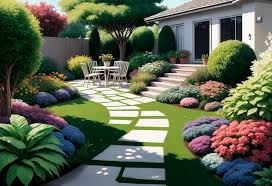In this post, you will learn the following:
*Definition and Scope
*Key Principles
*Modern Trends and Innovations
*Case Studies and Applications
Landscape design is a multidisciplinary field focused on creating and enhancing outdoor spaces to improve their aesthetic, functional, and environmental qualities. It encompasses the planning, design, and management of land and outdoor environments, blending art, ecology, and technology to craft spaces that respond to human needs and natural systems.

1. Definition and Scope
Landscape design involves designing both private and public outdoor spaces, including residential gardens, parks, urban plazas, and commercial properties. It aims to harmonize natural elements with built environments, ensuring that spaces are visually appealing, functional, and sustainable.
Scope of landscape design:
- Site Planning: Arranging land uses and structures to optimize functionality and aesthetics.
- Plant Selection and Layout: Choosing appropriate plant species for various conditions and designing plant arrangements to enhance beauty and ecological balance.
- Hardscaping: Incorporating non-plant elements like paths, walls, patios, and water features.
- Sustainability: Implementing practices that minimize environmental impact and promote ecological health.
- Cultural and Social Considerations: Reflecting cultural values and meeting the social needs of users.
2. Key Principles
a. Aesthetics and Functionality:
- Aesthetic Appeal: Design should create visually pleasing spaces through color, form, texture, and scale.
- Functional Use: Spaces must serve their intended purposes, whether for recreation, relaxation, or other activities.
b. Environmental Sustainability:
- Native Plants: Using indigenous plants that require less water and maintenance.
- Water Conservation: Implementing efficient irrigation systems and designing landscapes that minimize water use.
- Soil Health: Enhancing soil quality through organic matter and proper management.
c. Integration with Architecture:
- Harmony with Structures: Ensuring that landscape design complements and integrates seamlessly with existing or planned architecture.
- Spatial Flow: Creating transitions between indoor and outdoor spaces that are fluid and functional.
d. Human-Centric Design:
- Accessibility: Designing spaces that are accessible to people of all abilities.
- Safety: Considering safety aspects, such as proper lighting and visibility.
3. Modern Trends and Innovations
a. Green Infrastructure:
- Urban Greening: Incorporating green roofs, vertical gardens, and urban forests to enhance environmental quality and urban livability.
- Storm water Management: Designing landscapes to manage and filter storm water, reducing runoff and improving water quality.
b. Smart Landscaping:
- Technology Integration: Using smart irrigation systems, sensors, and data analytics to optimize landscape maintenance and resource use.
- Interactive Elements: Incorporating digital and interactive features that engage users and enhance their experience.
c. Climate Adaptation:
- Resilient Design: Developing landscapes that can withstand extreme weather events and adapt to changing climate conditions.
- Carbon Footprint Reduction: Implementing strategies to lower the carbon footprint of landscape designs, such as using sustainable materials and energy-efficient practices.
d. Community Engagement:
- Participatory Design: Involving community members in the design process to ensure that spaces meet their needs and preferences.
- Educational Opportunities: Designing landscapes that provide educational value about ecology, sustainability, and local heritage.
4. Case Studies and Applications
a. The High Line, New York City:
- Transformation: An abandoned railway turned into a vibrant urban park, integrating green space into a dense city landscape.
- Design Features: Incorporates native plants, art installations, and seating areas to create a unique public space.
b. Singapore’s Gardens by the Bay:
- Innovative Design: Features futuristic “Super trees” and climate-controlled conservatories, showcasing sustainable and cutting-edge landscape design.
- Sustainability Focus: Uses renewable energy, efficient irrigation, and promotes biodiversity.
c. The Eden Project, UK:
- Ecological Design: A series of biomes housing different plant species from around the world, emphasizing ecological education and conservation.
- Environmental Impact: Utilizes sustainable construction methods and renewable energy sources.
In conclusion, landscape design is a vital aspect of creating functional, beautiful, and sustainable outdoor environments. It blends artistic vision with environmental stewardship, addressing contemporary challenges such as climate change, urbanization, and resource conservation. By integrating modern trends and innovative practices, landscape design continues to evolve, contributing to healthier, more resilient, and more engaging outdoor spaces.



